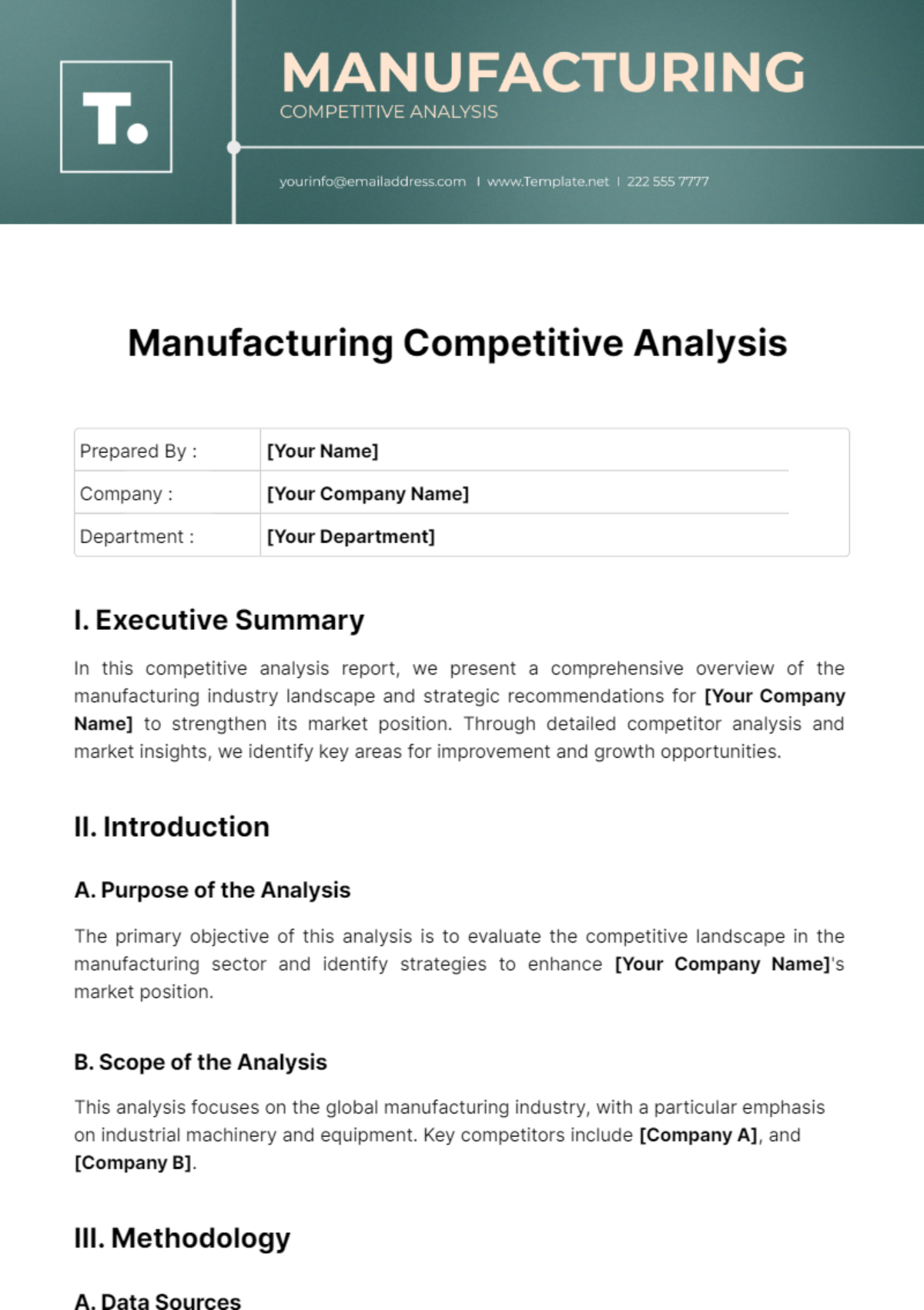Free Manufacturing Competitive Analysis

Prepared By : | [Your Name] |
Company : | [Your Company Name] |
Department : | [Your Department] |
I. Executive Summary
In this competitive analysis report, we present a comprehensive overview of the manufacturing industry landscape and strategic recommendations for [Your Company Name] to strengthen its market position. Through detailed competitor analysis and market insights, we identify key areas for improvement and growth opportunities.
II. Introduction
A. Purpose of the Analysis
The primary objective of this analysis is to evaluate the competitive landscape in the manufacturing sector and identify strategies to enhance [Your Company Name]'s market position.
B. Scope of the Analysis
This analysis focuses on the global manufacturing industry, with a particular emphasis on industrial machinery and equipment. Key competitors include [Company A], and [Company B].
III. Methodology
A. Data Sources
Industry reports from leading research firms such as Frost & Sullivan and MarketWatch.
Market surveys conducted among industry professionals and customers.
Financial statements of competitors obtained from public sources.
Customer feedback collected through surveys and interviews.
B. Analytical Framework
The analysis employs SWOT Analysis, Porter’s Five Forces, and PEST Analysis to assess the competitive landscape and identify strategic opportunities and threats.
IV. Industry Overview
A. Industry Landscape
The global manufacturing industry continues to grow, driven by advancements in technology and increasing demand for automation solutions. The market size is projected to exceed $10 trillion by 2050.
B. Key Trends and Drivers
Major trends include the adoption of Industry 4.0 technologies, increasing emphasis on sustainability, and growing demand for customized manufacturing solutions.
V. Competitive Analysis
A. Competitive Landscape
1. Competitor Analysis
Company A
Market Share: 20%
Key Products and Services: Industrial robots, automation solutions
Geographical Presence: North America, Europe, Asia-Pacific
Strategic Initiatives: Expansion into emerging markets, investment in R&D
Company B
Market Share: 15%
Key Products and Services: CNC machines, machining centers
Geographical Presence: Europe, Asia-Pacific
Strategic Initiatives: Focus on innovation, partnerships with technology firms
2. SWOT Analysis
[Your Company Name]
Strengths: Innovative product portfolio, strong brand reputation
Weaknesses: Limited global presence, high production costs
Opportunities: Expansion into emerging markets, technological advancements
Threats: Intense competition, regulatory challenges
VI. Market Position Assessment
A. Market Share Analysis
[Your Company Name] holds a 10% market share in the global manufacturing industry, ranking third among competitors.
Market Share Distribution in the Global Manufacturing Industry
B. Competitive Positioning
Product Differentiation: [Your Company Name]'s focus on innovative solutions sets it apart from competitors.
Pricing Strategy: Competitive pricing strategies are essential to remain attractive in the market.
Customer Satisfaction: Maintaining high levels of customer satisfaction is crucial for long-term success.
VII. Strategic Recommendations
A. Short-Term Strategies
Expand presence in key growth markets such as Asia-Pacific.
Enhance product features to meet evolving customer needs.
Optimize pricing strategies to remain competitive in the market.
B. Long-Term Strategies
Invest in research and development to drive innovation and stay ahead of competitors.
Strengthen partnerships with suppliers and distributors to improve market reach.
Implement sustainable manufacturing practices to align with growing environmental concerns.
VIII. Conclusion
In conclusion, this analysis provides valuable insights into the competitive landscape of the manufacturing industry and outlines strategic recommendations for [Your Company Name] to strengthen its market position. By leveraging its strengths and addressing key challenges, [Your Company Name] can capitalize on emerging opportunities and achieve sustainable growth in the years ahead.
- 100% Customizable, free editor
- Access 1 Million+ Templates, photo’s & graphics
- Download or share as a template
- Click and replace photos, graphics, text, backgrounds
- Resize, crop, AI write & more
- Access advanced editor
Discover the ultimate tool for strategizing your manufacturing business with Template.net's Manufacturing Competitive Analysis Template. This customizable and editable template offers comprehensive insights into market positioning, SWOT analysis, and strategic recommendations. Editable in our Ai Editor Tool, it's your key to staying ahead in the competitive landscape.





























